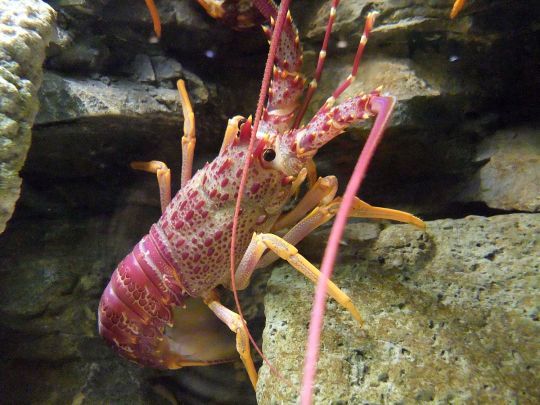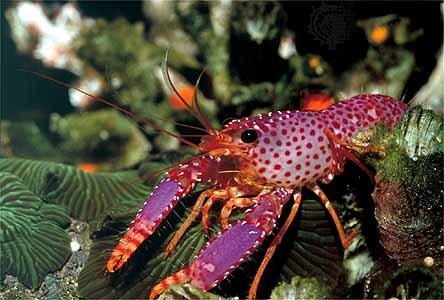#Enoplometopus occidentalis
Photo

A red reef lobster (Enoplometopus occidentalis) off the coast of Kona, Hawaii, USA
by Pierrette Wagner
#red reef lobster#reef lobsters#lobsters#crustaceans#Enoplometopus occidentalis#Enoplometopus#decapoda#Malacostraca#crustacea#arthropoda#wildlife: hawaii#wildlife: usa
438 notes
·
View notes
Note
Do you have any lobsters? My friend loves lobsters
DO I HAVE ANY LOBSTERS?!?!
I HAVE SO MANY LOBSTERS...
Let me show you... Here, let's have a look at lobsters from 3 different taxonomic groups...
SPINY LOBSTERS (family Palinuridae)

Southern Rock (Spiny) Lobster (Jasus edwardsii), family Palinuridae, found in coastal areas around Australia and New Zealand
photograph by Stemonitis

Ornate Rock Lobster (Panulirus ornatus), family Palinuridae, Fly Point, Port Stephens, NSW, Australia
photograph by Richard Ling

California Spiny Lobster (Panulirus interruptus), family Palinuridae, off the coast of California, USA
photograph by Brett Seymour | NPS
REEF LOBSTERS (family Enoplometopidae)

Violet-spotted Reef Lobster (Enoplometopus debelius), family Enoplometopidae, found around the Pacific Ocean
photograph by reef-guardian.com

Atlantic Reef Lobster (Enoplometopus antillensis), family Enoplometopidae, found in warmer parts of the Atlantic Ocean
photograph by Fernando Herranz Martín

Hawaiian Red Reef Lobster (Enoplometopus occidentalis), family Enoplometopidae, Hawaii
This species is normally red, but this individual has just molted.
photograph by Drew R. Smith
TRUE or TYPICAL LOBSTERS (family Nephropidae)

European Lobster (Homarus gammarus), family Nephropidae, found in the eastern Atlantic
photograph by H. Zell

American Lobster (Homarus americanus), family Nephropidae, found off the Atlantic coast of the NE U.S. and eastern Canada
photograph via: University of Maine
#lobster#decapod#crustacean#spiny lobster#reef lobster#ocean#homarus#nephropidae#Enoplometopus#Enoplometopus occidentalis)#family Enoplometopidae#Panulirus#palinuridae#jasus#aniamls#nature
445 notes
·
View notes
Photo

Freshly molted Hawaiian Red Reef Lobster, Enoplometopus occidentalis, on display at the Waikiki Aquarium.
The red coloration will emerge in a few hours, after molting.
photograph: Drew R. Smith | Wikipedia CC
71 notes
·
View notes
Photo

Mah Jongg Tile Set Description
Tile Set Name: FISHES.TIL
Subject: Tropical Fishes of the world
Created by: Ron Gemeinhardt
Description:
As any aquarium hobbyist or occasional pet-shop browser knows, there is no
shortage of color among the denizens of the world's oceans, rivers and other
bodies of water. This tile set is composed of common (and not so common)
aquarium dwellers--both freshwater and marine; vertebrates and invertebrates.
This set uses a direct-replacement scheme of tile substitution. Each suit in
the traditional Mah Jongg tile set has been replaced by a new suit, as
follows:
Freshwater fishes of Asia (replaces suit of dots; *=brackish water species):
1) Clown loach (Botia macracantha)
2) Red-tailed shark (Labeo bicolor)
3) Tiger barb (Capoeta tetrazona)
4) Black ruby barb (Puntius nigrofasciatus)
5) Archer fish (Toxotes jaculator) *
6) Mono (or Malayan angel) (Monodactylus argenteus) *
7) Pearl gourami (Trichogaster leeri)
8) Dwarf gourami (Colisa lalia)
9) Siamese fighting fish (Betta splendens)
Freshwater fishes of the Americas (replaces suit of bamboo):
11) Fancy guppy (Poecilia reticulata)
12) Angelfish (Pterophyllum scalare)
13) Firemouth (Cichlasoma meeki)
14) Tiger oscar (Astronotus ocellatus)
15) Neon tetra (Paracheirodon innesi)
16) Marbled hatchetfish (Carnegiella strigata)
17) Heckel discus (Symphysodon discus discus)
18) Green severum (Cichlasoma severum)
19) Dwarf gold ram (Microgeophagus ramerizi)
Coral reef fishes (replaces suit of characters):
21) Common clown (Amphiprion ocellaris)
22) Yellow tang (Zebrasoma flavescens)
23) Long-nosed butterflyfish (Forcipiger flavissimus)
24) Oriole angel (Centropyge bicolor)
25) Flame angel (Centropyge loriculus)
26) Blue devil (Pomacentrus coeruleus)
27) Regal tang (Paracanthurus hepatus)
28) Royal gramma (Gramma loreto)
29) Picasso triggerfish (Rhinecanthus aculeatus)
Miscellaneous aquarium dwellers (replace dragons):
10) Mystery snail (???)
20) Water flea (Daphnia sp.)
30) Florida seahorse (Hippocampus hudsonius)
Tropical invertebrates (higher orders; replace winds):
31) Hermit crab (Dardanus megistos)
32) Starfish (???)
33) Chambered nautilus (Nautilus pompilius)
34) Lobster (Enoplometopus occidentalis)
Tropical invertebrates (lower orders; replace seasons):
35) Nudibranch (Glossodoris sp.)
36) Sea fan (gorgon) (Gorgonarie acanthomuricea)
37) Featherduster worm (Sabella sp.)
38) Pipe organ coral (Tubipora musica)
Freshwater tropical plants (replace flowers):
39) Amazon sword (Echinodorus sp.)
40) Madagascar lace (Aponogeton madagascariensis)
41) Jungle val (Vallisneria americana)
42) Cryptocoryne (Cryptocoryne sp.)
Important note: To help you identify which tiles belong to these last two
suits, each has a common "ocean/river floor" color for all four tiles. The
plants are on a muddy brown bottom; the invertebrates rest on a dark gray
"coral sand" floor.
The notation ??? means no particular genus is represented. As for the
chambered nautilus--OK, so you'll NEVER see one in an aquarium, but it is a
pretty little beastie, isn't it?
(Incidentally, if you look carefully, you'll notice only the dwarf gourami,
pearl gourami and betta are blowing bubbles. These three fishes are able to
obtain oxygen from air as well as water--hence the bubbles.)
Some notes on legibility:
These tiles use cyan as the base color, rather than light gray, which may make
the default mouse cursor a bit hard to see. A bright cyan mouse cursor (color
number 11) works very well, and a black background (color 0) also improves the
display's appearance quite a bit. Also, since some of the fishes have rather
long names, the lettering on the tile faces is designed to minimize fatigue
and eyestrain, at the expense of a uniform character set.
125 notes
·
View notes
Text
Hawaiian Reef Lobster
A Peaceful and Intriguing Lobster From the Indo-Pacific – The Hawaiian Reef Lobster Referred to by scientists as Enoplometopus occidentalis, the Hawaiian reef lobster is a type of small lobster classified in the genus Enoplometopus. It is brightly colored, active and commonly found at a great... https://www.withinthesea.com/invertebrates/arthropods/crustaceans/lobsters/hawaiian-reef-lobster/
0 notes
Photo

ザリガニ界の美少女(でも名前は将軍)
@あわしまマリンパーク
31 notes
·
View notes